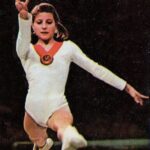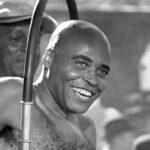Who Was Best In 2009? Serena, Clijsters, Safina, Kuznetsova, Azarenka?
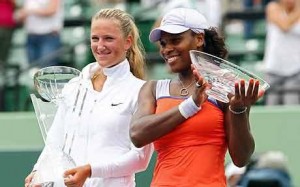
Serena Williams fell to Victoria Azarenka at the Sony Ericsson Open, but still had four of the top nine performances of 2009.
Return with us now to those thrilling ladies matches of yesterday when the heroine overcame an inspired opponent to win against overwhelming odds. Who gave the best performance by a female tennis player in 2009?
This list awaits you arranged somewhat in chronological order. You read, you judge, and then you vote to determine the best.
Which Female Tennis Player Had the Best Performance in 2009? Total Voters: 7
![]() Loading ...
Loading ...
Contributors in alphabetical order are: JA Allen, Marianne Bevis, Claudia Celestial Girl, and Shye Sentinele.
(1) Victoria Azarenka —Finals, 2009 Sony Ericsson Open
Then teenager Victoria Azarenka, now 20 and WTA No. 7, started 2009 ranked No. 17. When she entered the tournament in Key Biscayne, Azarenka was already a winner in Brisbane and Memphis. The lady from Belarus also came into Sony Ericsson with a strong performance at Indian Wells tucked away.
Her appearance in the Sony Ericsson final marked Azarkenka’s career best run at a premier event. The Belarusian had made quite a name for herself on the women’s tour for her intense competitive spirit and her quick and often hot temper. Sometimes, however, her outbursts lost her matches.
Serena Williams, on the other hand, had won this title often with five Miami titles added to her career total. Serena managed to reach another final for the seventh time by overcoming her sister Venus Williams in the semifinals and ensured she remained on top of the rankings.
Venus herself had won this championship three times. The question for Serena Williams, as the final got underway, was will the record sixth Sony Ericsson Open title be added to enrich the wonderful year she had enjoyed so far in 2009?
The two had met earlier in the year at the 2009 Australian Open. Azarenka had been leading in her fourth round match with Serena Williams 6-3 2-4 and had to retire due to illness. The fact that Williams went on to win the Australian Open must have eaten away at Azarkena. She hates losing.
The day was windy and conditions affected play. Williams lost her serve in her third game of the first set. Williams was not in perfect condition with an injured thigh, allowing Azarenka to take advantage by moving the younger Williams sister around the court—extracting forehand errors. As the set progressed, Williams serve continued to miss its mark. Azarenka won the first set 6-3.
In the second set, as the match faded away for Williams, she stood blankly in the middle of the court trying to dictate play almost without movement. In her mind she had lost already—Williams quit trying to win and just did what she needed to do to allow the match to continue, with only one person really in it. Azarenka won the second set 6-1.
It was the first big win for Azarenka who took the victory, regardless of the token opposition displayed by Serena Williams. Azarenka improved her ranking soaring into the top 10.
It marked the beginning of a wave of new young talent about to emerge in 2009, as older and more familiar faces began the process of fading away. Azarenka will make her presence felt in 2010, no doubt about it.
Nominated by Shye Sentinele
(2) Dinara Safina —Semifinals, BNL d’Italia in Rome
The beleaguered Dinara Safina ended the year with the troubles of the world on her shoulders.
Having struggled with back pain for much of the autumn, she was eventually forced to retire two games into the year-ending Tour Championships, and headed for a long period of treatment and rehabilitation. More unhappily, she exited 2009 with critics’ comments still ringing in her ears: How can someone without a Slam to their name be the world No. 1?
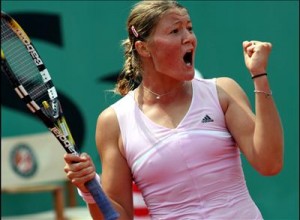
Dinara Safina spent much of 2009 as the number one player in the world despite not winning a major.
But that is exactly what Safina was, on and off, from April until those Tour Championships when she ignominiously lost the year-end No.1 ranking to Serena Williams.
But here is a woman who made the finals of the Australian Open and the French Open, and the semifinals of Wimbledon. She was runner-up in Sydney, Stuttgart, and Cincinnati, and she won in Portoroz. Hardly a poor record.
It was in May, however, when she showed why she deserved her No. 1 spot. She won back-to-back major titles in Rome and Madrid, sealing her 10th and 11th tour titles in quick succession.
And she really showed her metal during the Rome tournament, countering comments that she lacked the mental fortitude for the big moments.
She won her first match against Virginie Razzano in straight sets, but was two points away from falling to Zheng Jie in her second match, rallying from 5-2 down in the third to win 5-7, 6-1, 7-6(3).
In the quarters she also fought back from 6-4, 3-1 down, against María José Martínez Sánchez, closing out the match 6-0 in the third.
But it was in the semis that Safina showed her true grit, taking on Venus Williams in a titanic three-hour battle.
Williams took the first set in a tie-break and then broke Safina for a 2-0 lead in the second. But the Russian regrouped to win six of the next seven games and draw level. In the decider Safina was twice up a break, only to let Williams back into the match, but she finally won the decisive break to triumph in 6-7(3), 6-3, 6-4.
Nominated by Marianne Bevis
(3) Svetlana Kuznetsova —Finals, 2009 French Open Championship
It was the final between two Russian “Queens of Nerves.” Dinara Safina, WTA ranked No. 1, carried her nefarious reputation into the match because of her apparent inability to control her jangled jitters during a major final.
She had melted under the weight of pressure during the 2008 French Open final and the 2009 Australian Open final facing Serena Williams in January.
Now here she was back to compete in another French Open final after making her way admirably through six rounds at the 2009 French Open. She defeated Slovokian Dominika Cibulkova 6-3, 6-3 in the semifinals to reach the finals.
Svetlana Kuznetsova, winner of the 2004 U.S. Open Championship, had not made it back to a French Open final since 2006, when she met and lost to Justine Henin 6-4, 6-4. Her single major title had many dubbing her as a one-trophy wonder.
Kuznetsova had a very tough path through to the French Open finals. During the semifinals she had overcome Samantha Stosur 6-4, 6-7, 6-3 to reach the final.
Coming into the match at Roland Garros, the two Russian women were reigning supreme on clay and enjoyed superb records. Kutnetsova had won 15 of her 17 matches on clay that spring while Safina had captured 20 victories and suffered only one defeat. That defeat had been at Stuttgart against Kuznetsova.
The match itself was an “ugly” affair, lasting only 74 minutes. Safina contributed her inordinate share of unforced errors. It ended anticlimatically with Safina double-faulting.
In the end, with her experience, Kuznetsova managed to hang on to her nerves long enough to win the match. Safina once again came undone at the finish line. The No. 1 ranked Russian fought valiantly, breaking Kuznetsova in her opening game.
Eventually, however, the seventh seeded Russian came back and took control of the match from the baseline, where her powerful ground strokes found their mark and kept Safina pinned to the back of court, running side to side.
Kuznetsova also seemed to reach and return everything Safina threw at her. It was proving to be Kuznetsova’s day after all. Because she had suffered similar disappointments in the past, Kuznetsova sympathized with her compatriot’s case of nerves. Kutnetsova proved on that day that she was not a one-slam wonder.
Nominated by JA Allen
(4) Serena Williams —Semifinals, 2009 Wimbledon
“Miss Dementieva; Miss Williams …” They were supposed to have done away with that “old school” approach to refereeing the matches at Wimbledon!
While the umpiring might have been old school, the play was not. This was the best current tennis has to offer, exhibited by two wiley old veterans. Power from the baseline. Serve and half-volley. Power serving (120 mph from both players). Great gets. Great “presence” on-court from both players. Belief and will on display from both.
Serena exhibited her Rafa Nadal imitation (she admires him), with buggy-whip forehands that imparted spin and accuracy to her shots. Unlike Rafa, however, her UFEs (un-forced errors) can be relatively higher than Rafa’s. But not in this match.
Her opponent’s game can be characterized by double faults. But not in this match.
Serena breezed through the tournament up until this point. Poised and composed, effortlessly moving through, working those powerful groundstrokes to precision. Then she ran into Elena. Serena seemed dismayed by her opponent’s evident self-belief. The quality of play from Elena was high from the first point.
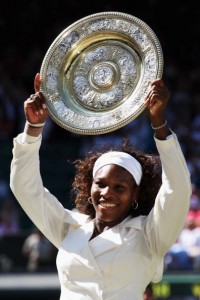
Serena Williams had back-to-back great performances to win Wimbledon.
This match put on display fantastic mid-court action by both contenders. That is, half-volleys with extreme angles resulting in fabulous gets, and or put-away forehands. I’d never seen either play exhibit such foot speed before.
While the odd UFE cost her the tie-break in the first set, Serena’s will to win was the difference in the balance of this high quality match. She fought off a crucial break point at 3-4 down in the second set.
In the third set, the audience was sure the match would go to Dementieva, as she had match point after a hard fought contest. But it was not to be. Serena fought off match point and prevailed 8-6 in the longest Ladies’ semi-final at Wimbledon in the open era (and of finest quality).
This was Serena at her best. Her opponent’s self-belief was on a par with her gold-medal performance in the Olympics, and her re-tooled serve was working like a charm. But the confluence of psychology and physical ability was still not enough to overcome Serena’s equally profound ability convolved with focus on the big points. Advantage Miss Williams.
Nominated by Claudia Celestial Girl
(5) Serena Williams —Finals, 2009 Wimbledon Championships
Venus Williams owned Wimbledon. It was her tournament—her surface of choice. She was doing battle for her third Wimbledon title in a row, her sixth overall. What is more, Venus was once again playing superb tennis, having defeated world No. 1 Dinara Safina 6-0, 6-1 in straight sets to reach the finals. In fact, Venus had not lost a set at Wimbledon since the third round in 2007.
Venus was, however, meeting her younger sister Serena in the finals. Serena had defeated Elena Dementieva in a hard fought semifinal contest to reach this point. It would mark the younger Williams’ sister fifth Wimbledon final. Serena had won two of their three on Centre Court. Head to head in finals they stood 10-10 and 2-2 on grass courts.
In 2008 the two sisters had met in the Wimbledon final and Venus had been victorious keeping the Rosewater Dish another year.
The first set was a clinic in serving, returning, and powerful ground strokes. The sisters were playing top-notch, all-court tennis. Venus had her leg heavily taped but hung with Serena until the tiebreak.
In the tiebreak, Venus’ game began to break down and she lost it 7-3. The first set went to Serena Williams in just under an hour.
In the second set Venus’ first serve began misfiring and she found herself down 4-2 with a break of serve against her. Serena served a love game, going up 5-2. The end was coming fast for the defending champion.
Venus’ unforced errors led to an impossible situation. Venus, however, fought off three match points before finally falling on the fourth. Serena Williams played the superior match and won the Wimbledon Championship that day, 7-6, 6-2 in 87 minutes. It was one of Serena’s best matches ever on Centre Court.
Nominated by the team.
(6) Kim Clijsters —Semifinals, U.S. Open Championships
What a match this promised to be with Serena Williams the obvious favorite coming into this U.S. Open semifinal contest against the “Come-Back Mom” Kim Clijsters. Clijsters had only defeated Williams once in her career—at the 2002 WTA Championships. Since then, Williams had won seven matches against the Belgian.
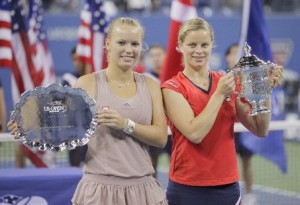
Kim Clijsters put together a magical run to win the 2009 U.S. Open.
Clijsters was making a return to action after she retired from the women’s tour in 2007. Should she win the tournament, her ranking would return to the top 20. The Belgian had received a huge amount of press coverage throughout the tournament because of her stellar play after a long absence on the big stage.
But the day had been long and went, and there were surprisingly few people in the stands when the match got underway. It was almost 9:30 EDT when play got underway. At the same time Yanina Wickmayer was playing Caroline Wozniacki in the other women’s semifinal contest. Rain had backed up the schedule of play the second week of the U.S. Open.
Clijsters continued her fastidious play by serving well and causing forehand errors by Williams. With Williams serving at 2-3 and aided by a double fault, Clijsters broke the American’s serve and went up 4-2. Williams immediately broke back, taking the set to 4-3 with Williams serving again.
Clijsters offered no hint of a break on her serve for the rest of this set. Breaking Williams serve in the 10th game, Clijsters took the opening set 6-4. In anger and frustration, Williams slammed her racket down.
It was the first time she had lost a set in this year’s Open. For that, Williams received a warning—which would play into the drama that unfolded at the conclusion of the match.
Williams opened the second set with grim determination and broke the Belgian’s serve; but Clijsters broke right back and the leveled the set at 1-1. Serena garnered another break of serve in the fifth game, leading 3-2; but once again, Clijsters broke back immediately.
They stayed on serve until Serena was serving to stay in the match at 5-6. It appeared they would be deciding the second set or the match in a tie break.
With Williams serving at 5-6 down, 15-30, she was called for a foot fault on her second serve. That meant the score was 15-40, giving Clijsters two match points on Williams’ serve.
That is when Williams shouted at the lines person who complained to the Chair Umpire—who assessed a code violation for unsportsmanlike conduct. Because Williams had a warning already assessed, the code violation gave Clijsters a penalty point and the match.
It was a bizarre ending to say the least. Clijsters really won the match on her play, not on the penalty point. Unfortunately, the match will be remembered for Serena Williams’ conduct and not Kim Clijsters play. Clijsters went on to win the final and claim the U.S. Open crown.
Nominated by JA Allen
Others to be considered :
(7) Serena Williams —Finals, 2009 Australian Open vs. Dinara Safina
Williams dominated Safina in this match which the American won 6-0, 6-3. The first set lasted 22 minutes, with Safina winning just eight points.
Williams won 95 per cent of points when she landed her first serve (20-for-21). Safina had 21 unforced errors, while Williams had seven. The Russian won just seven of 37 points on the Williams serve. Williams converted five of six break point opportunities.
(8) Kim Clijsters —Finals, 2009 U.S. Open vs. Caroline Wozniaki
It was the first slam final for the teenager Wozniaki who had played a magnificent tournament to reach the finals. The Belgian with superior experience held off Woznaicki, winning the match and the championship 7-5, 6-3.
(9) Serena Williams —Finals, WTA 2009 Championships in Doha vs. Venus Williams
Serena Williams got the best of her older sister Venus Williams again—beating her 6-2, 7-6 in the year-end championship tournament. This tournament was marred by player injuries; but at the end the two sisters stood ready to battle it out for the final trophy of the season. This has proven to be Serena’s year as she also won the Australian Open and Wimbledon in 2009.


